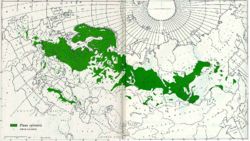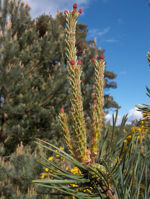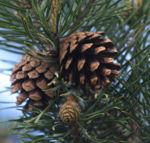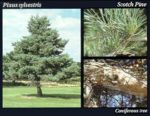Scots pine
| Scots Pine |
|---|

|
| Scientific Classification |
| Binomial Name |
|
Pinus sylvestris |
| Distribution |
The Scots pine tree will grow until it is roughly three hundred years old before dying. It has been used to make all sorts of things in the past and is still used today. There are lots of animal, plants, and bugs that live and thrive off it. It is native to England, but it can be grown in other places as well. This tree was going extinct due to over exploitation, but has been reintroduced to the countries that previously had it living there.
Anatomy
The age of the Scots Pine usually lasts up to one hundred and fifty years, but in some cases it can live up to three hundred years.[1]This tree grows to be about 36 meters in height, and about 1.5 meters around the bark. The younger pines are grey to greenish color. As they mature, they start to turn an orange or reddish shade, with fissures appearing as well. This color is more noticeable the higher you look up the tree. Its needles are a blue green, and are counted as leaves. These grow in pairs, but in case of the younger trees there can be up to three to four on strong shoots. [2] The leaves are 3-5 centimeters in length, although on younger more vigorous trees the leaves can be twice as long. [3]The root system for the Scots pine is either a deep taproot system, or a swallow root system. Having a different type of root system lets it grow in dry or wet soil, and at most elevations as well. It can survive in both good or poor quality soil.[4]
Reproduction
The cones of a Scots Pine are ovoid shape, and they come to a point. The cones grow to be about three to seven centimeters long, and have scales which protect the seeds inside of them. During the spring the scales open and the seeds are released. The connected spheres of pollen, which are from the male flowers, go out to fertilize the female flowers. There are usually hollows that are filled with lots of pollen. The pollen can also be found on the ground in large amounts. During the summer the fertilized flowers form green cones. The winged seeds take anywhere from a year and a half to three years to ripen. During the autumn the cones turn brown. [5]
Ecology
Scots Pine is one of the only species of pine native to Northern Europe. It usually forms a pure forest, but it can grow along side other types of pine. This tree previously grew in multiple areas of the British Isles, but it only grows in Scotland now. This is due to it getting cut down for houses and wood. The Scots Pine has been reintroduced to Ireland, Wales, and England where it has been over exploited. They are also restoring it to Denmark and the Netherlands.[6]There are different types of animals that like to live in and around this tree. Lichens and insects grow inside of the bark or around it. Certain birds like the Siskin, Great Spotted Woodpecker, Great Crested tit, and Crossbill feed very well on all the insects that thrive around the tree. The Wryneck and Capercaille can be found living in some pinewoods in Scotland. Certain birds of prey like the Golden Eagle, Osprey, and Goshawk like nesting on the level branches of the Scots Pine. The Red Squirrel likes the cones and seeds of the Scots Pine. [7]The Scots Pine does grow in North America, but it is considered an invasive tree. It grows in Wisconsin and Ontario. Even though it has an invasive property it does not grow properly in this country. It grows twisted and haphazard if taken care of properly. The cause of this is the temperature, and the soil contents that differ from England. People do not like looking at this tree because it looks very deformed and demented.[8]
Uses
The wood of the Scots Pine is a reddish color in the wood. This wood is easy to work with, is a very light-weight, and durable. After the finish of the wood is done, it has a yellow reddish tint to it. There are quite a few uses for it in the home. Some of these include: stairs, roofing, doorways, and skirting. It is also used to make furniture, as well as telegraph poles, fences, and paper pulp. Since the wood burns a nice scent, it is often used for firewood. They used to make ships, masts, and water wheels. They also used to make tar and turpentine from the resin of the bark. It was also used to make charcoal.[9]We also use the tree for the Christmas tree trade in the United States of America. [10]
 Browse |
Related References
- Scots Pine by Wikipedia
- Scots Pine Pinus sylvestris By British Trees
- Scots Pine By Forestry




